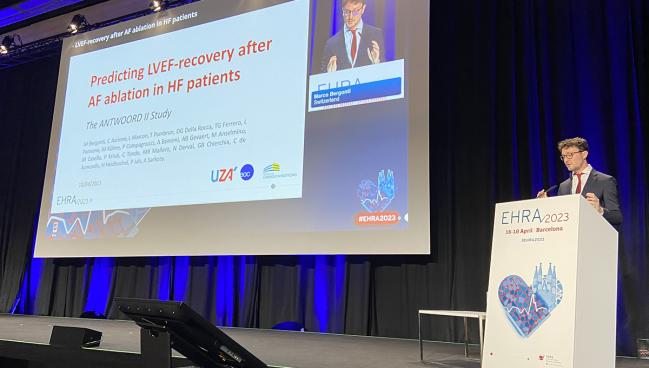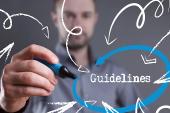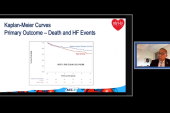Novel Score Identifies HF Patients With AF Who Respond to Ablation
The risk score should help physicians determine where ablation can help, but also where it won’t, say researchers.

BARCELONA, Spain—A novel score based on four easily measured variables can identify patients with systolic heart failure (HF) and atrial fibrillation (AF) who would benefit from catheter ablation, according to results of the ANTWOORD II study presented this week at the European Heart Rhythm Society (EHRA) 2023 congress.
The risk score can help physicians home in on who might respond to ablation with improvements in heart function, say researchers.
“Heart failure and atrial fibrillation often go together,” lead investigator Marco Bergonti, MD (Cardiocentro Ticino Institute, Lugano, Switzerland), told TCTMD. “About 30% of patients with heart failure will develop atrial fibrillation, and vice versa, with heart failure patients developing atrial fibrillation. It’s a large problem and a clinically relevant problem.”
In the past 15 years, a number of studies have attempted to understand the best treatment strategy for patients with both HF and AF, but the results have been mixed, said Bergonti. Studies have tested rhythm- and rate-control strategies, including catheter ablation for rhythm control versus medical therapy. In the ablation studies, CABANA-HF, CASTLE-HF, and AATAC suggested there was a benefit with ablation, but the RAFT-AF trial showed that ablation didn’t reduce the risk of mortality or HF events compared with rate control.
“The trials all go in directions, which when you think about it is quite normal because there are many different patients, with some where atrial fibrillation is the problem, and if you solve it, then the patient will get better,” said Bergonti. “In other patients, atrial fibrillation is just a bystander. If you treat it, nothing will change. Then you’re putting a patient on the table for no reason.”
Isabelle Van Gelder, MD, PhD (University Medical Center Groningen, the Netherlands), who discussed the study following the late-breaking presentation, said the new risk score is important given the conflicting data. “It’s a very diverse group,” she said. “Everybody here knows that CASTLE-AF was positive, but it was not the only study and it was a very select group of patients.”
Nevertheless, the clinical guidelines do endorse first-line ablation in select patients with AF and HF, she said.
In Europe, AF catheter ablation is a class I recommendation to reverse LV dysfunction in AF patients “when tachycardia-induced cardiomyopathy is highly probable.” This recommendation is independent of the patient’s symptoms. Ablation carries a weaker recommendation—class IIa—to improve survival and reduce HF hospitalizations in selected AF patients who have HF with reduced ejection fraction (HFrEF). In the US, catheter ablation may be reasonable in selected patients with symptomatic AF and HFrEF—a class IIb recommendation—based on the CASTLE-AF results.
“In clinical practice, it’s very difficult to know who should be selected for an ablation and who should not,” said Van Gelder.
Score Predicts LVEF Responders
In a prior study, the researchers had identified four predictors of LVEF recovery and used those to develop a risk score, known as the ANTWERP score. The four variables include QRS interval, paroxysmal AF, severe atrial dilation, and known HF etiology. Two points each are awarded for a known HF etiology and QRS interval > 120 ms and one point each for paroxysmal AF and severe atrial dilation. In ANTWOORD I, the score performed well (AUC 0.93), with a lower score associated with a higher likelihood of LVEF recovery.
To validate the score in ANTWOORD II, researchers studied 605 patients (mean age 61 years; 24% female) with systolic HF referred for AF ablation at eight European centers. Of these, 63% had HFrEF and 37% had HF with mildly reduced EF (HFmrEF).
Overall, 70% of patients “responded” to the ablation, which was defined as an improvement in LVEF. For those with HFmrEF, LVEF ≥ 50% at 1 year was defined as a response to treatment while LVEF > 40% plus an absolute 10% increase was considered a response in those with HFrEF. Those who responded to ablation had fewer HF hospitalizations and lower mortality than nonresponders. They were also more likely to show signs of positive ventricular remodeling. In terms of AF outcomes, responders had significantly less AF recurrence at 1 year.
The ANTWERP score performed well for predicting LVEF improvement, with an AUC of 0.86 (95% CI 0.82-0.89). For patients with scores of 0, 1, 2, 3, 4, and 5-6, the proportion of those who responded to ablation with an improvement in LVEF was 94%, 92%, 82%, 51%, 40%, and 17%, respectively.
Future Trial With HF Docs
To TCTMD, Bergonti said the goal with catheter ablation in AF is to reduce recurrence, but that the endpoints of importance in HF patients are hospitalizations and mortality. Still, the goal is to reduce the burden of AF, he said, noting that an analysis from CASTLE-AF showed that AF burden less than 50% at 6 months was associated with a lower rate of all-cause mortality and HF hospitalizations.
In terms of the score, the HF etiology aspect is probably the “weakest,” said Bergonti, noting that getting to the bottom of the cause of HF can be difficult and could involve extensive testing, depending “on how deep you want to go.” Nonetheless, the ANTWERP score provides physicians with a tool to identify those who will do best with catheter ablation, and this can help inform discussions with patients.
“I don’t think it’s really useful at the moment to try to understand if ablation works for everybody,” said Bergonti. “It won’t.”
Van Gelder said the score is clinically helpful because the parameters are easily assessed in practice based on the ECG and echocardiography. She raised some concerns about the response definition, questioning the clinical implications of relatively small increases in LVEF, particularly in HFmrEF. Nonetheless, the vast majority of patients with an ANTWERP score of 0-1 had improvements in function and should likely undergo ablation as early as possible, which is supported by the EAST-AFNET 4 trial, said Van Gelder.
She pointed out that HF pharmacology has improved dramatically in recent years and questioned whether these patients were optimized on all available medications, including SGLT2 inhibitors. There is a potential for referral bias in the present study, she said, noting that the score was validated in patients referred for AF ablation.
“If you aim to do a randomized trial, please do it in cooperation with our heart failure colleagues,” said Van Gelder.
Bergonti agreed there is some debate about how to best define HF recovery, with different trials using different definitions. However, the researchers defined HF response to ablation based on the 2021 Universal Definition of Heart Failure from Heart Failure Society of America, the Heart Failure Association of the European Society of Cardiology, and the Japanese Heart Failure Society.
Michael O’Riordan is the Managing Editor for TCTMD. He completed his undergraduate degrees at Queen’s University in Kingston, ON, and…
Read Full BioSources
Bergonti M, Ascione C, Marcon L, et al. Predicting LVEF-recovery after AF ablation in HF patients. Presented at: EHRA 2023 Congress. April 18, 2023. Barcelona, Spain.
Disclosures
- Bergonti reports no relevant conflicts of interest.





Comments